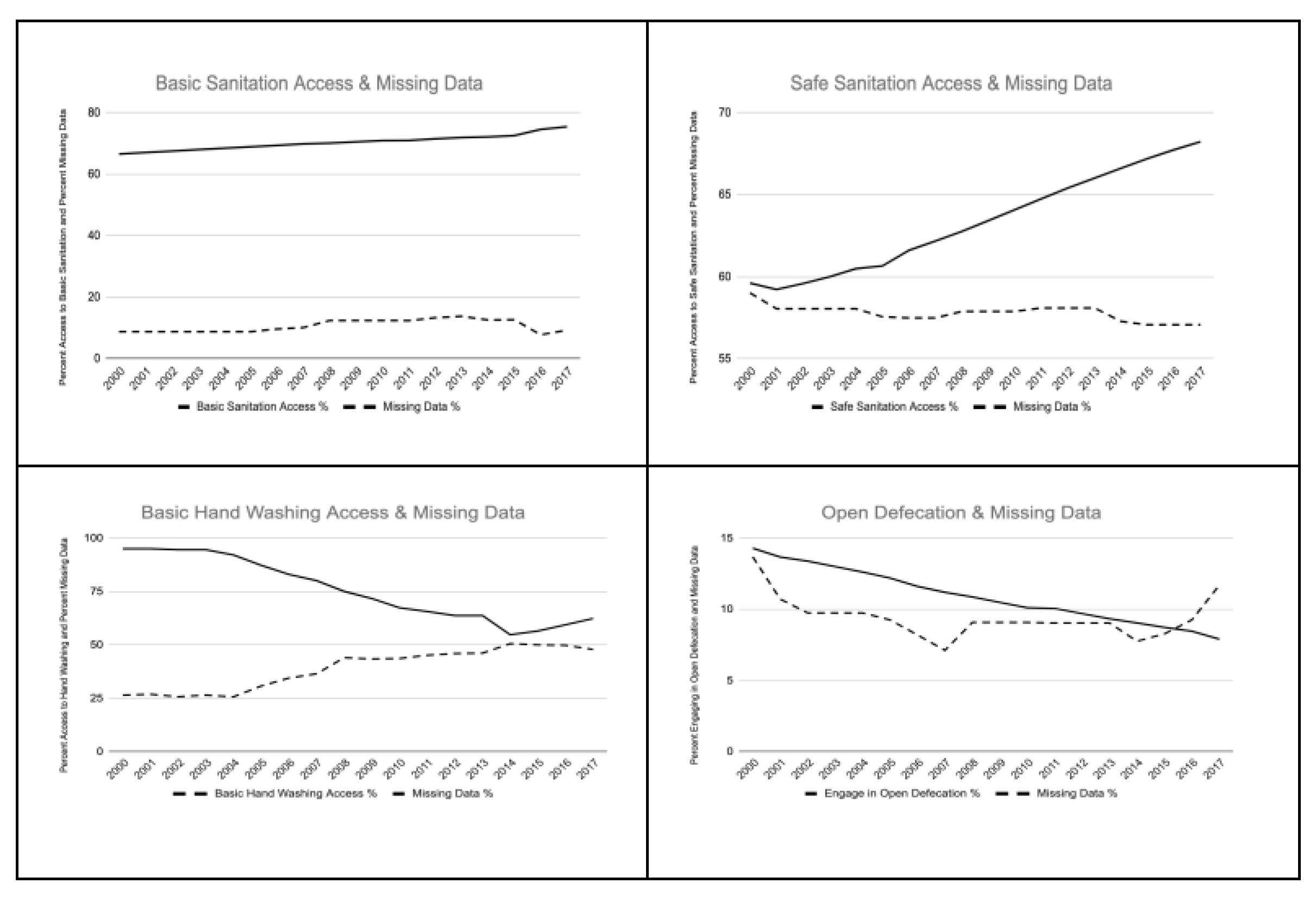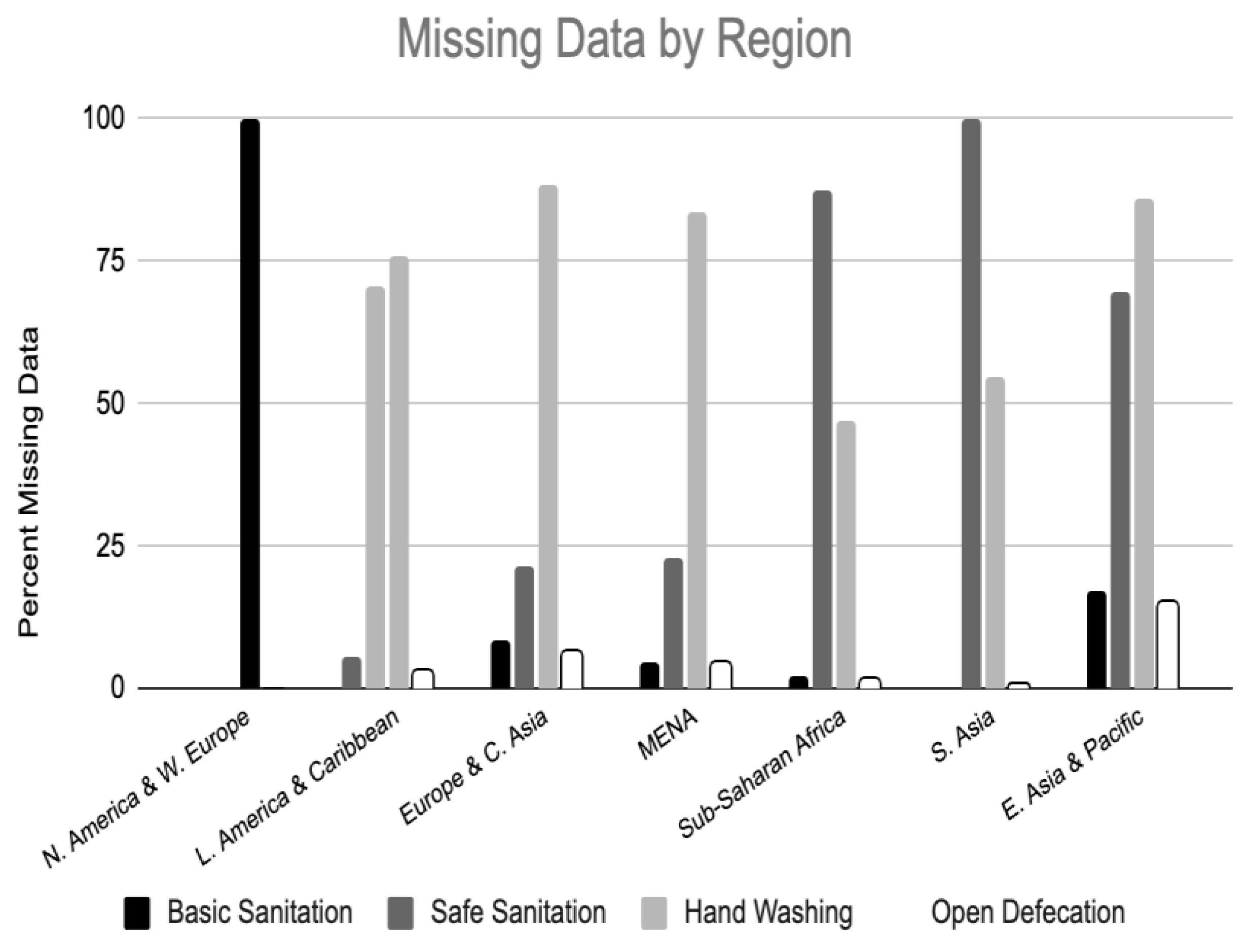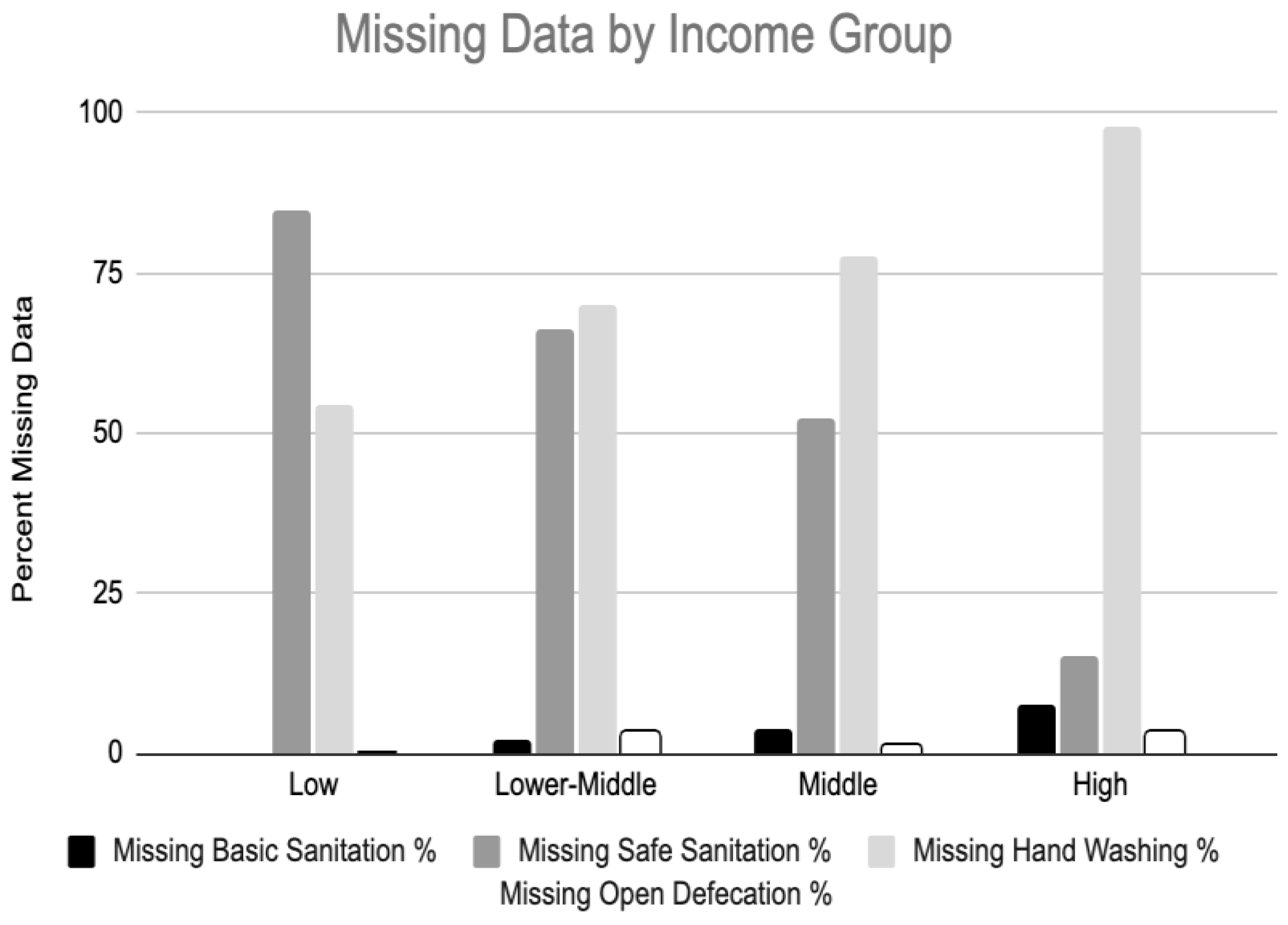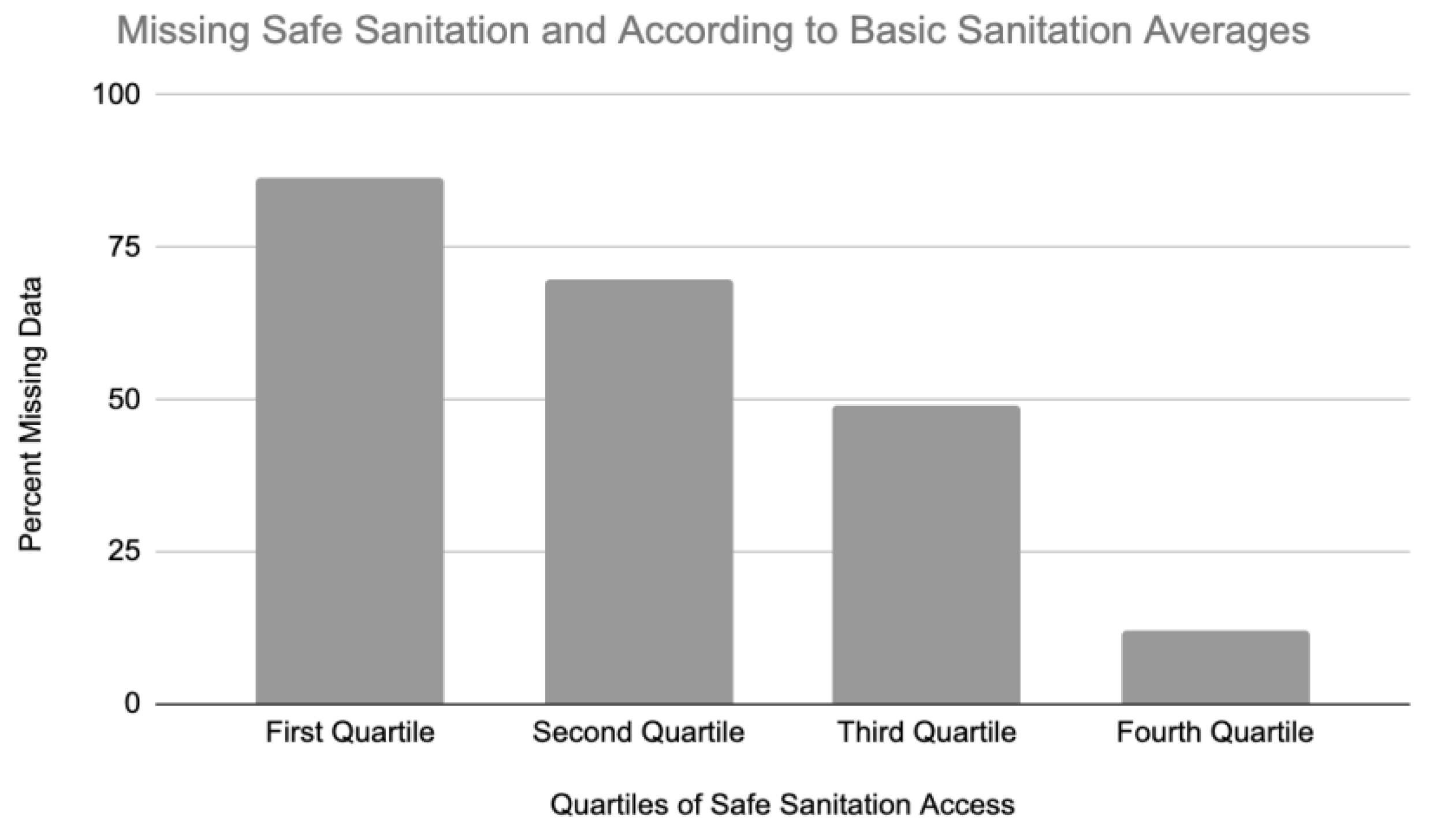The Determinants of Access to Sanitation: The Role of Human Rights and the Challenges of Measurement
Abstract
:1. Introduction
2. Sanitation, Access, & Human Rights: A Review
2.1. Progress on Sanitation
2.2. Determinants of Access to Sanitation
2.3. Access to Sanitation as a Human Right
2.4. Impact of Human Rights
3. Assessing Available Sanitation Data
4. Results
Data and Methods
5. Conclusions
Author Contributions
Funding
Data Availability Statement
Acknowledgments
Conflicts of Interest
References
- UN. General Assembly. The Human Right to Water and Sanitation. U.N. Doc A/64/L.63/Rev.1, Para. 1. Available online: https://undocs.org/A/64/L.63/Rev.1 (accessed on 19 March 2021).
- United Nations Conference on Water, Mar del Plata Action Plan (1977), Mar Del Plata Action Plan Resolution, Preamble. Available online: https://www.internationalwaterlaw.org/bibliography/UN/Mar_del_Plata_Report.pdf (accessed on 19 March 2021).
- United Nations. Division for the Advancement of Women. In Convention on the Elimination of All Forms of Discrimination against Women; United Nations: New York, NY, USA, 1981. [Google Scholar]
- United Nations, Committee on Economic, Social and Cultural Rights. General Comment No. 15, The Human Right to Water and Sanitation, U.N. Doc. E/C.12/2002/11. Available online: https://www.undocs.org/e/c.12/2002/11 (accessed on 19 March 2021).
- Langford, M.; Bartram, J.; Roaf, V. The Human Right to Sanitation. In The Human Right to Water: Theory, Practice and Prospects; Langford, M., Russell, A., Eds.; Cambridge University Press: Cambridge, UK, 2017; pp. 345–395. [Google Scholar]
- Winkler, I. The Human Right to Sanitation. Univ. Pa. J. Int. Law 2016, 37, 1331. [Google Scholar]
- Patunru, A. Access to Safe Drinking Water and sanitation in Indonesia. Asia Pac. Policy Stud. 2015, 2, 234–244. [Google Scholar] [CrossRef]
- Cumming, O.; Elliot, M.; Overbo, A.; Bartram, J. Does global progress on sanitation really lag behind water? An Analysis of global progress in community- and household-level access to safe water and sanitation. PLoS ONE 2014, 9, e114699. [Google Scholar] [CrossRef] [PubMed] [Green Version]
- Bartram, J. Improving on Haves and Have-Nots. Nature 2008, 452, 283–284. [Google Scholar] [CrossRef] [PubMed]
- Armah, F.; Ekumah, B.; Yawson, D.; Odoi, J.; Afitiri, A.; Nyieku, F. Access to improved water and sanitation in sub-Saharan Africa in a quarter century. Heliyon 2018, 4, e00931. [Google Scholar] [CrossRef] [PubMed] [Green Version]
- Millennium Development Goals. United Nations Millennium Goals. Available online: https://www.un.org/millenniumgoals/environ.shtml (accessed on 26 March 2021).
- UNICEF and World Health Organization. Progress on Sanitation and Drinking Water: 2015 Update and MDG Assessment. 2015. Available online: https://www.who.int/water_sanitation_health/publications/jmp-2015-update/en/ (accessed on 19 March 2021).
- The Millennium Development Goals Report. United Nations Millennium Development Goals. 2015. Available online: https://www.un.org/millenniumgoals/2015_MDG_Report/pdf/MDG%202015%20rev%20(July%201).pdf (accessed on 21 March 2021).
- Goal Number Six Identifies Eight Targets for 2030, Two of Which Are Directly Related to Safely Managed Sanitation Access. These Targets Include Achieving Access to: (1) “Adequate and Equitable Sanitation and Hygiene for all and an End to Open Defecation, Paying Special Attention to the Needs of Women and Girls and Those in Vulnerable Situations”; and (2) “Halving the Proportion of Untreated Wastewater and Substantially Increasing Recycling and Safe Reuse Globally”. “Water and Sanitation”. United Nations Sustainable Development. Available online: https://www.un.org/sustainabledevelopment/water-and-sanitation/ (accessed on 22 March 2021).
- United Nations, Department of Economic and Social Affairs, Sustainable Development. Progress. Available online: https://sdgs.un.org/goals/goal6 (accessed on 19 March 2021).
- World Health Organization. Definitions of Indicators. Available online: https://www.who.int/water_sanitation_health/monitoring/jmp04_2.pdf (accessed on 22 March 2021).
- SDG Tracker: Clean Water and Sanitation. Sustainable Development Goal 6. Available online: https://sdg-tracker.org/water-and-sanitation (accessed on 21 March 2021).
- UN Statistics. Sustainable Development Goals Report. 2020. Available online: https://unstats.un.org/sdgs/report/2020/goal-06/ (accessed on 21 March 2021).
- Abubakar, I. Access to sanitation facilities among Nigerian households: Determinants and sustainability implications. Sustainability 2017, 9, 547. [Google Scholar] [CrossRef] [Green Version]
- Adams, E.; Boateng, G.; Amoyaw, J. Socioeconomic and Demographic Predictors of Potable Water and Sanitation Access in Ghana. Soc. Indic. Res. 2016, 126, 673–687. [Google Scholar] [CrossRef]
- Rheingans, R.; Anderson, J.; Luyendijk, R.; Cumming, O. Measuring Disparities in Sanitation Access: Does the measure matter? Trop. Med. Int. Health 2014, 1, 2–13. [Google Scholar] [CrossRef] [PubMed] [Green Version]
- Andersson, P.; Kumar, N.; Sokou, E.; Roman, O.Z.; Wang, Y.; Savić, P. Inequality of Opportunity in Asia and the Pacific: Water and Sanitation. Social Development Policy Papers #2018-5. Available online: https://www.unescap.org/sites/default/d8files/knowledge-products/Water_Sanitation_report_20181122.pdf (accessed on 11 June 2021).
- Van Minh, H.; Viet Hung, N. Economic Aspects of Sanitation in Developing Countries. Environ. Health Insights 2011, 5, 63–70. [Google Scholar] [CrossRef] [PubMed]
- Ndikumana, L.; Pickbourn, L. The Impact of foreign aid allocation on access to social services in sub-Saharan Africa: The Case of water and sanitation. World Dev. 2017, 90, 104–114. [Google Scholar] [CrossRef]
- Lawrence, J.; Yeboah-Antwi, K.; Biemba, G.; Ram, P.; Osbert, N.; Sabin, L.; Hamer, D. Beliefs, Behaviors, and Perceptions of Community-Led Total Sanitation and Their Relation to Improved Sanitation in Rural Zambia. Am. J. Trop. Med. Hyg. 2016, 94, 553–562. [Google Scholar] [CrossRef] [PubMed]
- WaterAid. Available online: https://www.wateraid.org/us (accessed on 14 June 2021).
- Centre on Housing Rights and Evictions (COHRE). Available online: https://www.cohre.org/ (accessed on 14 June 2021).
- COHRE; UN-HABITAT; WaterAid; SDC. Sanitation: A Human Rights Imperative; COHRE: Geneva, Switzerland, 2008; p. 5. [Google Scholar]
- International Conference on Water and the Environment: Development Issues for the 21st Century, ‘Dublin Statement on Water and Sustainable Development’, U.N. Doc. A/Conf.151/PC/112 (1992). Emphasis Added. It Was Not a Formal Govern-Ment Declaration, but the Statement Was Endorsed by International Experts from a Hundred Countries. It Is Also a Formal U.N. Document. Available online: https://www.gdrc.org/uem/water/dublin-statement.html (accessed on 14 June 2021).
- UN-Habitat. The Habitat Agenda Goals and Principles, Commitments and the Global Plan of Action; UN-Habitat: Nairobi, Kenya; Istanbul, Turkey, 1996; para. 11. [Google Scholar]
- In Proceedings of the 17th Plenary Meeting of the World Summit on Sustainable Development, Johannesburg, South Africa, 4 September 2002. Available online: https://www.un.org/esa/sustdev/documents/WSSD_POI_PD/English/POI_PD.htm (accessed on 14 June 2021).
- General Comment No. 15 (2002), Para. 3 States, “Article 11, Paragraph 1, of the Covenant Specifies a Number of Rights Ema-Nating from, and Indispensable For, the Realization of the Right to an Adequate Standard of Living ‘Including Adequate Food, Clothing and Housing.’ the Use of the Word ‘Including’ Indicates That This Catalogue of Rights Was Not Intended to Be Exhaus-Tive. The Right to Water Clearly Falls within the Category of Guarantees Essential For Securing an Adequate Standard of Living, Particularly since It Is One of the Most Fundamental Conditions for Survival. Moreover, the Committee Has Previously Rec-Ognized That Water Is a Human Right Contained in Article 11, Paragraph 1, (See General Comment No. 6 (1995)). The Right to Water Is Also Inextricably Related to the Right to the Highest Attainable Standard of Health (Art. 12, Para. 1) And the Rights to Adequate Housing and Adequate Food (Art. 11, Para. 1). The Right Should Also Be Seen in Conjunction with Other Rights en-Shrined in the International Bill of Human Rights, Foremost Amongst Them the Right to Life and Human Dignity.” Para. 4 Continues, “the Right to Water Has Been Recognized in a Wide Range of International Documents, Including Treaties, Declara-Tions and Other Standards”. Available online: https://www.unhcr.org/en-us/publications/operations/49d095742/committee-economic-social-cultural-rights-general-comment-15-2002-right.html (accessed on 14 June 2021).
- The United Kingdom Delegation Abstained in the Vote Because They Claimed there Was Insufficient Legal Basis for Recognizing Water or Sanitation as Freestanding Human Rights and that there Was No Evidence that the Rights Existed in Customary law. General Assembly Adopts Resolution Recognizing Access to Clean Water, Sanitation. UN Information Release. 28 July 2010. Available online: http://www.un.org/News/Press/docs/2010/ga10967.doc.htm (accessed on 11 June 2021).
- “The Committee Reaffirms that, since Sanitation is Fundamental for Human Survival and for Leading a Life in Dignity, the Right to Sanitation is an Essential Component of the Right to an Adequate Standard of Living, Enshrined in Article 11 of the International Covenant on Economic, Social and Cultural Rights. The Right to Sanitation is also Integrally Related, among other Covenant Rights, to the Right to Health, as Laid down in Article 12 paragraphs 1 and 2 (a), (b) and (c), the Right to Housing, in Article 11, as Well as the Right to Water, Which the Committee Recognized in Its General Comment No. 15.”UN Committee on Economic, Social and Cultural Rights. Statement on the Right to Sanitation. (Forty-Fifth Session, 2010), UN Doc. E/C.12/2010/ 1, Para. 7. Available online: https://undocs.org/en/A/HRC/15/31 (accessed on 14 June 2021).
- UN Human Rights Council. Report of the Independent Expert on the Issue of Human Rights Obligations Related to Access to Safe Drinking Water and Sanitation, Catarina de Albuquerque. (Fifteenth Session, 2010) UN Doc. A/HRC/15/31, Paras. 13–54. Available online: https://undocs.org/en/A/HRC/15/31 (accessed on 14 June 2021).
- States with constitutional rights to water include the “Democratic Republic of the Congo, Ecuador, Maldives, Mexico, Nicaragua, Solomon Islands, South Africa, Uganda, United States of America (at state level), and Uruguay…” Heller, L. “Statement by the Special Rapporteur on the human rights to safe drinking water and sanitation”. 28 July 2020. Available online: https://www.ohchr.org/EN/NewsEvents/Pages/DisplayNews.aspx?NewsID=26116&LangID=E (accessed on 14 June 2021).
- Committee on Economic, Social and Cultural Rights. General Comment 4, The Right to Adequate Housing. (Sixth Session, 1991), U.N. Doc. E/1992/23, Annex III at 114 (1991), Para. 8(b). Available online: https://www.refworld.org/pdfid/47a7079a1.pdf (accessed on 14 June 2021).
- Committee on Economic, Social and Cultural Rights. General Comment 14, the Right to the Highest Attainable Standard of Health. (Twenty-Second Session, 2000), U.N. Doc. E/C.12/2000/4 (2000), Para 4. Available online: https://www.refworld.org/pdfid/4538838d0.pdf (accessed on 14 June 2021).
- Wilson, E.F. Human Rights-Based Approach to Development: The Right to Water. Neth. Q. Hum. Rights 2005, 23, 213–241. [Google Scholar] [CrossRef]
- Banik, D. Support for Human Rights-Based Development: Reflections on the Malawian Experience. Int. J. Hum. Rights 2010, 14, 32–48. [Google Scholar] [CrossRef]
- Joel Bolnick, a Co-founder of Slum Dwellers International, for Example, Rejects a Rights-Based Approaches. He Believes That “Public Declarations Have a Habit of Compromising Our Capacity to Negotiate with and on Behalf of Organised Shack Dwellers”. J. Bolnick, ‘Slum-Friendly Approach: Sdi Letter to the Witness in Response to Article by Ndivhuwo WA Ha Mabaya’ (2009). Available online: https://abahlali.org/node/4859/ (accessed on 14 June 2009).
- Ramphele, M. Cited in P. Green, ‘100 days, 11 issues’. Mail & Guardian, 17 August 2009. [Google Scholar]
- Dembour, M.-B. What Are Human Rights? Four Schools of Thought. In Human Rights Quarterly; The Johns Hopkins University Press: Baltimore, MD, USA, 2010; Volume 32, pp. 1–20. [Google Scholar]
- Neocosmos, N. Civil Society, Citizenship and the Politics of the (Im)possible: Rethinking Militancy in Africa Today. Interface 2009, 1, 263–334. [Google Scholar]
- Langford, M. Critiques of Human Rights. Annu. Rev. Law Soc. Sci. 2018, 14, 69–89. [Google Scholar] [CrossRef]
- Sikkink, K. Evidence for Hope: Making Human Rights Work in the 21st Century; Princeton University Press: Princeton, NJ, USA, 2017. [Google Scholar]
- Langford, M.; Rodriguez, C.; Ross, J. (Eds.) Social Rights Judgments and the Politics of Compliance: Making It Stick; Cambridge University Press: Cambridge, UK, 2017. [Google Scholar]
- Schiel, R.; Langford, M.; Wilson, B.M. Does it matter? Constitutionalisation, democratic governance, and the human right to water. Water 2020, 12, 350. [Google Scholar] [CrossRef] [Green Version]
- Crawford, S.; Brocklesby, M.A. Assessing the Impact of a Right to Sanitation on Improving Levels of Access and Quality of Services: Summary; DFID Draft Working Paper; OECD: Paris, France, 2011. [Google Scholar]
- WASHWatch. South Asia/Nepal: Summary. Available online: http://www.washwatch.org/southern-asia/nepal (accessed on 11 June 2017).
- Langford, M. The Right to Water and Sanitation in Development Cooperation: The State of Play and the European Union; Briefing Paper for the European Parliament; European Parliament: Brussels, Belgium, 2012. [Google Scholar]
- Rampal and Ors v. State of Rajasthan and Ors. AIR1981Raj121 (4 September 1980). Available online: https://www.legitquest.com/case/rampal-sharma-and-others-v-state-of-rajasthan/1c0eb0 (accessed on 14 June 2021).
- Human Rights Case No. 9—K/1992; Supreme Court of Pakistan, Unreported Judgment. Available online: https://www.supremecourt.gov.pk/cause-list-search/ (accessed on 14 June 2021).
- Karachi Administration Employees Co-operative Housing Society and the Karachi Water and Sewerage Board (KWSB). Available online: http://www.kwsb.gos.pk/ (accessed on 14 June 2021).
- Legal Resources for the Right to Water and Sanitation: International and National Standards, 2nd ed.; COHRE: Geneva, Switzerland, 2008.
- Robins, S. Toilets that became political dynamite. Cape Times, 27 June 2011. [Google Scholar]
- Beja and Others v Premier of the Western Cape and Others. [2011] 3 All SA 401 (WCC)) [2011] ZAWCHC 97, 21332/10 (29 April 2011). Available online: http://www.saflii.org/za/cases/ZAWCHC/2011/97.html (accessed on 14 June 2021).
- Kiewietz, J.; Jooste, B. Residents elated to have enclosed toilets. IOL News, 29 August 2011. [Google Scholar]
- Justice Erasmus also Criticised the Two Parties’ Politicisation of the Toilet Issue at the Expense of the Community and Directly Questioned Youth League’s Integrity. The Judgment Stated: “What has Become Evident Is that the [ANC Youth League] had a Core Function of Promoting the Interests of the City Contractor … Not only Was the [ANC Youth League] in the Pocket of the Contractor but His Role Undermined the Principle of Community Participation”. Beja v Premier of the Western Cape. (n. 228 above), Para. 104. Available online: http://www.saflii.org/za/cases/ZAWCHC/2011/97.html (accessed on 14 June 2021).
- Dugard, J. Basic Services in Urban South Africa: Rights, Reality and Resistance. In Symbols or Substance? The Role and Impact of Socio-Economic Rights Strategies in South Africa; Langford, M., Cousins, B., Dugard, J., Madlingozi, T., Eds.; Cambridge University Press: Cambridge, UK, 2013. [Google Scholar]
- Liebenberg, S. Nokotyana & Ors. v. Ekurhuleni Municipality 2010 (4) BCLR 312 (CC). The Court did not address the existence of a constitutional right to sanitation, rather it focused on the legislation in its decision. In Socio-Economic Rights: Adjudication under a Transformative Constitution; Juta Academic: Cape Town, Western Cape, South Africa, 2010; pp. 455–456. [Google Scholar]
- Joint Monitoring Programme: WHO & UNICEF. Sanitation. Available online: washdata.org (accessed on 22 March 2021).
- Elkins, Z.; Ginsburg, T.; Melton, J. Comparative Constitutions Project: Characteristics of National Constitutions. 2005 [2021]. Characteristics of National Constitutions [v.2.0]. Available online: comparativeconstitutionsproject.org (accessed on 9 June 2021).
- Jung, C.; Hirschl, R.; Rosevear, E. Economic and Social Rights in National Constitutions. Am. J. Comp. Law 2014, 62, 1043–1093. [Google Scholar] [CrossRef] [Green Version]
- Habyarimana, J.; Humphreys, M.; Posner, D.; Weinstein, J. Why does ethnic diversity undermine public goods provision? Am. Political Sci. Rev. 2007, 101, 709–725. [Google Scholar] [CrossRef] [Green Version]
- Wimmer, A.; Cederman, L.A.; Min, B. Ethnic politics and armed conflict. A configurational analysis of a new global dataset. Am. Sociol. Rev. 2009, 74, 316–337. [Google Scholar] [CrossRef] [Green Version]
- Wendling, Z.A.; Emerson, J.W.; Esty, D.C.; Levy, M.A.; de Sherbinin, A. 2018 Environmental Performance Index; Yale Center for Environmental Law & Policy: New Haven, CT, USA, 2018. [Google Scholar]




| Variable | Obs. | Mean (%) | Std. Dev. | Min (%) | Max (%) | Missing (%) |
|---|---|---|---|---|---|---|
| Open Defecation | 3371 | 10.921 | 17.713 | 0 | 84.59 | 9.43 |
| Basic Sanitation | 3325 | 70.374 | 29.913 | 6.6 | 100 | 10.67 |
| Safe Sanitation | 1571 | 63.346 | 30.307 | 3.163 | 100 | 57.79 |
| Basic Handwashing | 905 | 44.354 | 33.083 | 0.859 | 100 | 75.69 |
| Variable | Obs. | Mean | Std. Dev. | Min | Max |
|---|---|---|---|---|---|
| Basic Sanitation | 3325 | 70.37 | 29.91 | 6.6 | 100 |
| Open Defecation | 3371 | 10.92 | 17.71 | 0 | 84.59 |
| Sanitation Right | 3642 | 0.115 | 0.319 | 0 | 1 |
| Water Right | 3752 | 0.194 | 0.396 | 0 | 1 |
| Health Right | 3474 | 1.083 | 0.842 | 0 | 2 |
| GDP pc (ln) | 3003 | 8.244 | 1.602 | 4.664 | 12.174 |
| Ethnolinguistic Fractionalization | 1642 | 0.408 | 0.279 | 0.001 | 0.925 |
| Population (ln) | 3450 | 15.479 | 2.212 | 9.148 | 21.05 |
| Area (ln) | 3095 | 2.54 | 0.19 | 1.515 | 2.87 |
| EPI | 1942 | 53.296 | 11.894 | 15 | 91 |
| (1) Sanitation | (2) Water | (3) Health | |
|---|---|---|---|
| Rights | −5.00762 | −4.81011 | 0.95469 |
| (5.82758) | (4.83942) | (2.38882) | |
| GDP per capita | 2.74563 ** | 2.74770 ** | 2.76599 ** |
| (ln) | (0.48338) | (0.48287) | (0.48090) |
| Fractionalization | −45.86664 ** | −46.24426 ** | −45.82849 ** |
| (8.56423) | (8.63061) | (8.57493) | |
| Population (ln) | 6.66139 ** | 6.62304 ** | 6.51812 ** |
| (2.48829) | (2.48337) | (2.43654) | |
| Area (ln) | −54.18238 * | −53.30422 * | −54.26008 * |
| (26.18145) | (26.34412) | (26.35693) | |
| EPI | 0.29475 ** | 0.29466 ** | 0.29488 ** |
| (0.10673) | (0.10680) | (0.10634) | |
| Constant | 85.03706 + | 83.85600 + | 85.71024 + |
| (47.86404) | (47.98090) | (48.32989) | |
| Observations | 1334 | 1334 | 1334 |
| (1) Sanitation | (2) Water | (3) Health | |
|---|---|---|---|
| Rights | 3.65621 | 3.65090 | −1.84974 |
| (4.18866) | (3.65458) | (1.52376) | |
| GDP per capita | −1.74369 ** | −1.74785 ** | −1.77068 ** |
| (ln) | (0.46369) | (0.46064) | (0.46317) |
| Fractionalization | 18.30207 ** | 18.59557 ** | 18.31598 ** |
| (5.37350) | (5.39858) | (5.40123) | |
| Population (ln) | −6.41315 ** | −6.35129 ** | −6.24453 ** |
| (2.05595) | (2.05384) | (2.00366) | |
| Area (ln) | 50.90849 ** | 49.98533 * | 50.99265 ** |
| (19.66807) | (19.61335) | (19.60441) | |
| EPI | −0.14825 | −0.14806 | −0.14917 |
| (0.09756) | (0.09731) | (0.09672) | |
| Constant | −1.67740 | −0.65768 | −1.70055 |
| (31.22260) | (31.18719) | (31.69330) | |
| Observations | 1323 | 1323 | 1323 |
Publisher’s Note: MDPI stays neutral with regard to jurisdictional claims in published maps and institutional affiliations. |
© 2021 by the authors. Licensee MDPI, Basel, Switzerland. This article is an open access article distributed under the terms and conditions of the Creative Commons Attribution (CC BY) license (https://creativecommons.org/licenses/by/4.0/).
Share and Cite
Schiel, R.; Wilson, B.M.; Langford, M. The Determinants of Access to Sanitation: The Role of Human Rights and the Challenges of Measurement. Water 2021, 13, 1676. https://doi.org/10.3390/w13121676
Schiel R, Wilson BM, Langford M. The Determinants of Access to Sanitation: The Role of Human Rights and the Challenges of Measurement. Water. 2021; 13(12):1676. https://doi.org/10.3390/w13121676
Chicago/Turabian StyleSchiel, Rebecca, Bruce M. Wilson, and Malcolm Langford. 2021. "The Determinants of Access to Sanitation: The Role of Human Rights and the Challenges of Measurement" Water 13, no. 12: 1676. https://doi.org/10.3390/w13121676
APA StyleSchiel, R., Wilson, B. M., & Langford, M. (2021). The Determinants of Access to Sanitation: The Role of Human Rights and the Challenges of Measurement. Water, 13(12), 1676. https://doi.org/10.3390/w13121676








